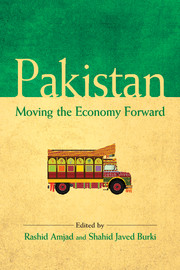Book contents
- Frontmatter
- Contents
- List of figures and tables
- Preface
- 1 Overview
- 2 Failed Economic Promise: Lessons from Pakistan's Development Experience
- 3 Economic Management Under IMF Tutelage: Key Lessons from the Musharraf and PPP Rule 1999–2013
- 4 A Country and an Economy in Transition
- 5 Tackling the Energy Crisis
- 6 Exports: Lessons from the Past and the Way Forward
- 7 The Future Path of Tax Reforms in Pakistan
- 8 Pakistan's Indus Basin Water Strategy: Past, Present and Future
- 9 Economic Governance and Institutional Reforms
- 10 Benefiting from Foreign Direct Investment
- 11 An Analysis of the Remittances Market in Pakistan
- 12 The Prospects for Indo-Pakistan Trade
- 13 Beyond the Poverty Line: A Multidimensional Analysis of Poverty in Pakistan
- 14 Can the New Intergovernmental Structure Work in Pakistan? Learning from China
- Contributors
- Index
10 - Benefiting from Foreign Direct Investment
Published online by Cambridge University Press: 05 May 2015
- Frontmatter
- Contents
- List of figures and tables
- Preface
- 1 Overview
- 2 Failed Economic Promise: Lessons from Pakistan's Development Experience
- 3 Economic Management Under IMF Tutelage: Key Lessons from the Musharraf and PPP Rule 1999–2013
- 4 A Country and an Economy in Transition
- 5 Tackling the Energy Crisis
- 6 Exports: Lessons from the Past and the Way Forward
- 7 The Future Path of Tax Reforms in Pakistan
- 8 Pakistan's Indus Basin Water Strategy: Past, Present and Future
- 9 Economic Governance and Institutional Reforms
- 10 Benefiting from Foreign Direct Investment
- 11 An Analysis of the Remittances Market in Pakistan
- 12 The Prospects for Indo-Pakistan Trade
- 13 Beyond the Poverty Line: A Multidimensional Analysis of Poverty in Pakistan
- 14 Can the New Intergovernmental Structure Work in Pakistan? Learning from China
- Contributors
- Index
Summary
Introduction
It is commonly held that foreign direct investment (FDI) has played an insignificant role in Pakistan's economic development. Certainly, the aggregate data supports this view: FDI inflows have accounted for less than 1 per cent of gross domestic product (GDP) in most of Pakistan's 60-plus years, and less than 4 per cent in the peak year of 2007 when the country ranked among the 10 largest recipients of FDI in Asia. At the same time, FDI has been more important in Pakistan than in India: annual inflows have been larger in most years from 1947 to 1993, and even now, while our larger neighbor receives four times more inflows, the share of FDI in capital formation is three times as large in Pakistan. Such comparison, while superficial, suggests the relevance of FDI.
This chapter considers the role that FDI can play in moving the economy forward by improving its technological base and placing production on a more dynamic growth path, as other countries have done with great success. It begins with a brief history to remind readers that Pakistan's economy has always been open to foreign investment, even in the heyday of nationalization. Next, it looks at the particular type of investment and technological profile that has evolved: weighty, but largely insular, statist, and low on competiveness. Finally, the chapter assesses the potential for a more ambitious industrial trajectory: private-sector-led, fueled by FDI, and supported by policies and institutions that encourage technological deepening.
The course of Foreign Direct Investment (FDI) in Pakistan
Foreign companies have operated in Pakistan since even before independence. Standard Chartered Bank claims a heritage of over 140 years, to operations set up in Karachi in 1863. Shell Petroleum dates its operations back to 1903 and Imperial Tobacco to 1905. Siemens opened an office in Lahore in 1922 and Imperial Chemical Industries (ICI) set up a soda ash manufacturing facility in Khewra in 1944.
- Type
- Chapter
- Information
- PakistanMoving the Economy Forward, pp. 254 - 279Publisher: Cambridge University PressPrint publication year: 2015

